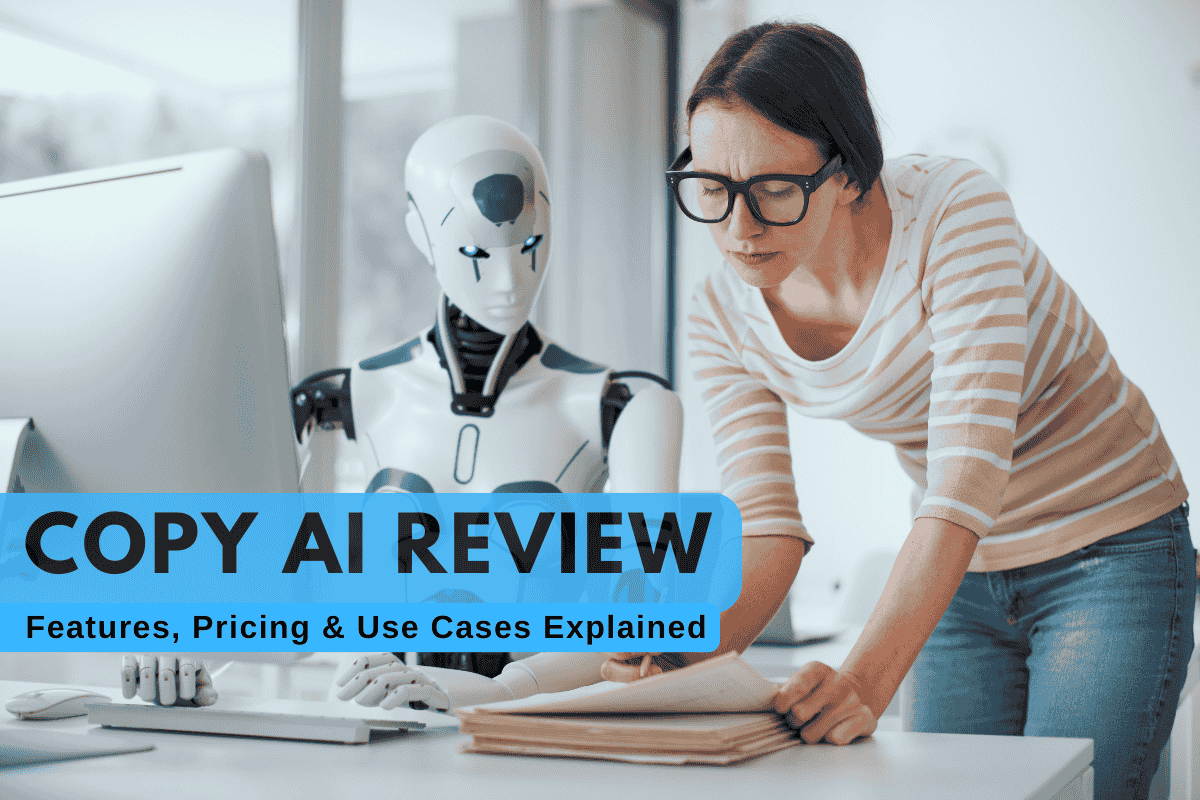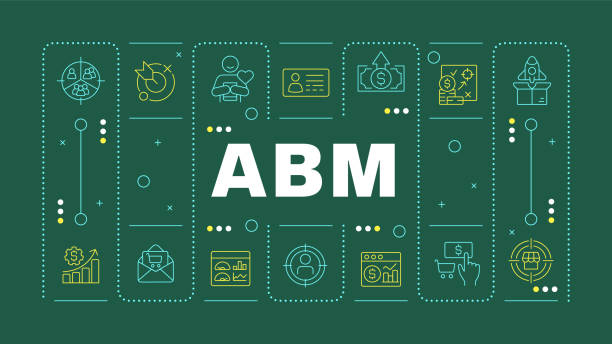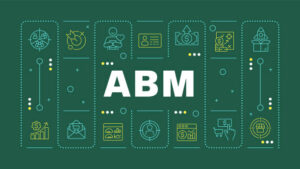What is Copy.ai and How Does It Work?
In 2025, as AI writing tools redefine content creation, Copy.ai remains a strong contender. This review examines its key features, practical use cases, pricing, and compares it to tools like Jasper AI and ChatGPT. If you’re a marketer, blogger, or business owner aiming to speed up content production, you’ll get clear insights into what Copy AI offers, how to use it effectively, and whether it’s the right fit for your workflow—no fluff, just facts.
Stay with us for a no-fluff, data-backed, and up-to-date copy ai review—a detailed look at how copy ai performs as a powerful AI copywriting software.
What is Copy AI and How Does It Work?
Copy.ai is an AI writing assistant that automates content creation using natural language processing and deep learning. Powered by OpenAI’s GPT-3 and GPT-4, it quickly generates contextual, high-quality text based on simple prompts.
Launched in October 2020 by Paul Yacoubian and Chris Lu, it started with basic ad copy and social content. By 2025, it had evolved into a full-scale AI content platform used by thousands of businesses globally.
With a simple interface, users can create blog posts, product descriptions, emails, and more—without needing technical skills.
How it works:
Select a template (like a blog post or email), enter a prompt, and Copy.ai generates multiple content drafts instantly. You can edit, refine, or export the result. The tool also learns from user feedback to improve over time.
What makes it different:
Copy.ai focuses on brand voice, supports multilingual output, and delivers fast yet context-aware writing, giving it an edge over other AI tools.
Who Is Copy.ai For? Best Use Cases and Ideal Users in 2025
Copy.ai isn’t just another generic AI content tool — it’s tailored for real users with specific needs. Whether you’re running a one-person blog or managing content for a fast-growing agency, Copy ai delivers output that adapts to your workflow.
Let’s break down who benefits the most from using it:
Marketers
If you’re a digital marketer juggling email campaigns, ad copy, and SEO content, Copy.ai helps you generate conversion-ready drafts in minutes. For example, a solo marketer at a startup can create 5 different Facebook ad variants using the Ad Copy Generator without relying on a full creative team.
Bloggers
For blog writers looking to beat writer’s block, the Blog Post Wizard structures full articles based on a single prompt. A travel blogger, for instance, could type “Top things to do in Tokyo” and instantly receive a full blog outline, intro, and section content — ready to refine and publish.
E-commerce Store Owners
Struggling with hundreds of product descriptions? Copy.ai’s Product Description Generator can rewrite or create them in bulk. Imagine an Etsy shop owner needing fresh product blurbs for 50 new handmade items — Copy.ai gets it done in one sitting.
Startups
For lean teams, Copy.ai acts as a 24/7 AI marketing assistant. A startup founder launching a SaaS app can use it to generate landing page copy, email flows, and pitch decks — all without hiring a content writer.
Agencies
Agencies love the team collaboration features. A small creative agency can delegate writing tasks like blog outlines, ad variations, and emails to junior staff with Copy.ai — cutting content turnaround time by half.
Non-Tech Users
Even if you’ve never used an AI tool before, Copy.ai’s interface is simple and intuitive. A small business owner with no writing or marketing background can type a sentence and get polished social captions, product blurbs, or email drafts instantly.
This kind of audience-fit clarity is something many AI tools miss. But Copy ai stands out by combining ease of use with powerful automation, making it ideal for both beginners and professionals.
Copy.ai Key Features (2025 Edition)
Copy.ai has evolved far beyond simple ad copy generation. In 2025, it will offer a robust suite of AI-powered tools designed to streamline content workflows for businesses, marketers, and creators.
Here’s a deep dive into its most important features, with real examples of how they’re used in day-to-day operations.
Blog Post Wizard
This tool allows users to generate full-length blog articles from a single prompt. You input your topic, choose the tone, and Copy AI creates an outline, intro, and section-wise content.
Example: A SaaS founder wants to publish a blog titled “How to Reduce Churn Using Email Onboarding”. By entering this into the Blog Post Wizard, they receive an SEO-friendly blog structure with draft content in under 10 minutes.
Why it matters: Traditional blog writing can take 3–5 hours. Copy.ai reduces this to under 30 minutes — perfect for startups and solopreneurs.
Email Generator
This feature crafts cold outreach, follow-up, or newsletter emails based on your goal and audience.
Example: A marketing agency creating a cold outreach campaign for local gyms can generate five versions of persuasive emails, A/B test subject lines, and tweak tones — all within Copy.ai’s email tool.
Useful For: Sales teams, freelancers, agencies doing high-volume outreach.
Social Media Tools
Social content takes time to write and optimize. Copy.ai includes caption generators, hashtag suggesters, and post idea templates for platforms like Instagram, LinkedIn, Facebook, and X (formerly Twitter).
Example: A fashion brand preparing a product launch can generate 10 unique Instagram captions with call-to-action, tone matching, and hashtags — customized by audience type.
Real-world win: One user reported saving 15+ hours a month on social content alone.
Brand Voice (NEW in 2025)
This new feature allows you to train Copy.ai on your brand’s tone, style, and messaging rules, ensuring all outputs match your identity.
Example: A DTC skincare company uploads past newsletters and website content. Copy.ai learns its soft, educational tone — and starts producing on-brand content automatically.
Advantage: You get consistent messaging across all touchpoints — even if different team members generate content.
Copy.ai Chat (GPT-powered assistant)
This is Copy.ai’s real-time AI writing assistant, similar to ChatGPT but integrated within the platform — optimized for marketing use cases.
Use it for:
- Writing ad copy on the fly
- Summarizing articles
- Rewriting content in a new tone
- Answering SEO-related content questions
Example: A content manager pastes a rough blog outline and asks Copy.ai Chat to rewrite it in a “professional but friendly” voice — getting a clean, edited version instantly.
Templates Library (90+ use cases)
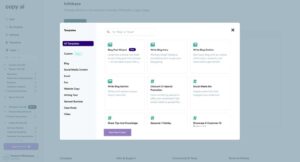
Copy.ai offers a wide library of templates for:
- Blog posts
- Sales copy
- Facebook ads
- LinkedIn updates
- YouTube video ideas
- TikTok hooks
- Product descriptions
- Business bios, and more
Example: A freelancer can generate a cold outreach message, a client proposal, and a landing page draft — all by selecting different templates.
Time-saving: Each template is fine-tuned for specific use cases, cutting down trial-and-error.
Built-in Workflows & Automation
You can create multi-step content workflows. For example:
- Generate a blog post
- Summarize it for LinkedIn
- Extract quotes for Twitter
- Turn it into an email campaign
Example: A content strategist sets up a workflow for weekly blog repurposing — handled 100% inside Copy.ai.
Benefit: This brings real content automation to small teams and solo marketers.
Multilingual Content Generation
Copy.ai supports 25+ languages, making it ideal for global businesses.
Example: A Shopify seller operating in the U.S. and Spain can generate product descriptions in English and Spanish with one click — maintaining consistency across markets.
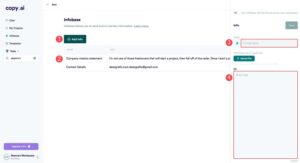
Real-World Use Cases of Copy.ai
What separates Copy.ai from many other AI writing tools is how practical and versatile it is in real-world scenarios. Whether you’re managing an online business, working solo, or running campaigns for clients, this tool adapts to real needs.
Here’s how users across industries are applying Copy.ai in daily workflows:
Writing Full Blog Posts
Blogging consistently is hard. Copy.ai makes it easier by helping users draft long-form blog posts from just a few keywords or a topic idea.
Example: A personal finance blogger enters “how to save money on groceries” and receives a full outline with intro, body, and CTA — all in under 10 minutes. Instead of writing from scratch, they now spend time refining content.
Impact: Reduces blog writing time by 70%, allowing creators to publish more frequently and stay relevant.
Generating Social Captions
Social media is fast-paced — and so is Copy.ai’s social caption generator. It creates ready-to-post content based on your product, message, or event.
Example: A small business launching a new skincare product uses Copy.ai to generate 10 Instagram captions, including product benefits, emojis (optional), and calls to action.
Result: The founder saves time, avoids repetition, and gets consistent brand messaging across platforms.
Creating Product Descriptions
Writing unique descriptions for dozens (or hundreds) of products is time-consuming. Copy.ai’s product description generator can bulk-create or rewrite listings for Amazon, Shopify, Etsy, and more.
Example: An Amazon seller with 50 tech accessories uses Copy.ai to rewrite all product descriptions to make them SEO-optimized and engaging — leading to improved CTR.
Bonus: Supports multiple tones and formats, such as bullet points or paragraphs.
Writing Cold Outreach Emails
Writing cold emails that convert is a challenge. With Copy.ai’s email generator, users create personalized outreach sequences that feel human — not robotic.
Example: A freelance designer targeting startups enters a short pitch, and Copy.ai generates 3 email variations, including subject lines. The emails are direct, personalized, and action-driven.
Real win: Higher open and response rates with minimal manual editing.
Creating YouTube Scripts
For video creators, Copy.ai can generate intro hooks, outlines, or full scripts based on a video topic.
Example: A tech YouTuber enters “top 5 productivity tools for remote work” and gets a structured video script — including opening hook, list breakdown, and CTA.
Use case: Speeds up video planning and helps non-writers create better content.
Startup Business Ideas
Copy.ai isn’t limited to content creation — it can help brainstorm ideas. Using the “Startup Ideas” tool, users can generate unique, niche-specific business ideas.
Example: An aspiring entrepreneur types “AI + education” and Copy.ai outputs five startup ideas — each with descriptions, target audience, and monetization models.
Value: Perfect for those stuck in the idea phase or building pitch decks.
Resume & Cover Letters
Job seekers can use Copy.ai to write professional resumes, bios, and cover letters — customized to each role.
Example: A marketing graduate pastes their work history and desired job title, and Copy.ai generates a compelling cover letter in a professional tone.
Real benefit: Saves hours and improves the quality of applications, especially for non-native English speakers.

Copy.ai Pricing Plans
Copy AI pricing offers flexible plans for freelancers, startups, teams, and enterprises. Whether you’re testing Copy AI as a free AI writing assistant or scaling up with advanced features, there’s a plan that fits. Based on multiple copy AI reviews, the tool is seen as affordable and high-performing for content needs in 2025.
Below is a quick, clear pricing overview:
| Plan | Key Details |
| Free | $0/month, 1 seat, 2,000 words in chat, ChatGPT 3.5 & Claude 3 support, Copy.ai brand voice, Infobase access, community support. Perfect for personal use and testing AI. |
| Starter (Monthly) | $49/month, 1 seat, unlimited chat words, unlimited projects, access to the latest LLMs, and private community support. Ideal for freelancers or solo marketers creating consistent content. |
| Starter (Annual) | $36/month (billed at $432/year), same features as Starter, discounted annually. |
| Advanced (Monthly) | $249/month, up to 5 seats, 2,000 workflow credits, 15+ marketing & sales workflows, workflow builder, live chat support. Best for growing teams or agencies managing large campaigns. |
| Advanced (Annual) | $186/month (billed at $2,232/year), same Advanced features, discounted for annual billing. |
| Enterprise | Custom pricing, unlimited seats, guided onboarding, API/bulk workflows, 20+ integrations, dedicated success team, enterprise-grade security. Best for complex or large-scale AI-powered content operations. |
Copy.ai Pricing Breakdown: Is It Worth the Money?
When evaluating an AI copywriting tool, pricing is a key factor for long-term value. Copy.ai offers competitive plans for everyone, from freelancers to agencies.
Free Plan — Ideal for individuals testing AI, with enough credits to explore templates and social captions. For example, an Etsy seller uses it to create product titles weekly, saving hours.
Starter Plan — Suited for freelancers and bloggers scaling content, with unlimited chat words and advanced templates at $49/month or $36/month billed annually. A content writer doubled article output with its long-form generator and brand voice features.
Advanced Plan — Built for teams and agencies, includes workflow credits, marketing/sales workflows, and supports up to 5 users for $249/month or $186/month annually. A SaaS marketing team uses it to produce ad sets and landing pages for multiple clients.
Enterprise Plan — Designed for large organizations with custom needs, offering API access, workflow automation, advanced security, and dedicated support. Pricing is custom-quoted. A global eCommerce brand automated 100,000+ product descriptions using a trained brand-tone model.
Is Copy.ai Pricing Justified?
For solo creators, the Starter plan delivers strong value, while the Advanced and Enterprise plans help scale production with collaboration and automation. Compared to Jasper or Writesonic, Copy.ai stands out with advanced NLP, multilingual support, constant updates, and flexible pricing.
Copy.ai vs Competitors
In a saturated market of AI writing tools, Copy.ai holds its ground by offering a user-friendly interface, diverse templates, and NLP-powered features — but how does it stack up against popular alternatives like Jasper, Writesonic, and ChatGPT?
Let’s compare them using real criteria marketers care about: accuracy, speed, cost-efficiency, NLP capability, and usability.
Copy.ai vs Jasper
| Feature | Details |
|---|---|
| NLP Engine | Copy.ai: GPT-4 Jasper: GPT-4 + custom fine-tuning |
| Templates | Copy.ai: 90+ Jasper: 50+ (sales-focused) |
| Ease of Use | Copy.ai: Beginner-friendly Jasper: Needs onboarding |
| Pricing | Copy.ai: Starts free Jasper: $49+/month |
| Collaboration | Both support teams |
| Best For | Copy.ai: startups, marketers Jasper: enterprises |
Jasper is known for context retention and tone adaptability, but Copy.ai outperforms for users seeking quick turnaround and scalable short-form generation. For example, a Shopify seller creating 20 product descriptions daily would find Copy.ai faster and simpler. So Copy.ai is faster for short-form copy. Jasper suits large teams with deep brand voice controls.
Copy.ai vs Writesonic
| Feature | Details |
|---|---|
| NLP Model | Both use GPT-4 |
| Templates | Copy.ai: 90+ Writesonic: 80+ |
| SEO Tools | Copy.ai: Basic Writesonic: Surfer SEO integration |
| Plagiarism | Copy.ai: None Writesonic: Included |
| Ease of Use | Copy.ai: Simpler Writesonic: Moderate |
| Best For | Copy.ai: ads, product copy Writesonic: blog SEO |
A digital marketing freelancer using Copy.ai can produce Facebook ad variations, email copy, and Instagram captions in under 10 minutes — compared to Writesonic, which may require more formatting and setup.
Copy.ai speeds up social posts and ad variations; Writesonic is better for blogs with SEO.
Copy.ai vs ChatGPT
| Feature | Details |
| Focus | Copy.ai: copywriting
ChatGPT: general assistant |
| Templates | Copy.ai: 90+
ChatGPT: none |
| NLP | Copy.ai: GPT-4 fine-tuned
ChatGPT: GPT-3.5/4 |
| Ease of Use | Copy.ai: very simple
ChatGPT: moderate |
| Price | Copy.ai: free to $49+
ChatGPT: free to $20 |
| Best For | Copy.ai: marketing copy
ChatGPT: research, brainstorming |
ChatGPT is a natural language processing engine more suited for general tasks. In contrast, Copy.ai is pre-trained on marketing workflows like email subject lines, product descriptions, and landing page copy. It eliminates the need for prompt engineering.
Copy.ai saves time with built-in copy workflows, while ChatGPT handles broader tasks.
Which Tool is Best for You?
- Use Copy.ai if you want speed, ease, and prebuilt NLP templates. Great for entrepreneurs, copywriters, and marketers.
- Choose Jasper if your brand demands high-quality, long-form SEO articles and tighter brand voice integration.
- Go with Writesonic if you need blog articles with Surfer SEO support and plagiarism checks.
- Use ChatGPT for broader tasks like brainstorming, research, or chatbot development.
For scaling e-commerce or digital marketing copy, Copy.ai’s automated templates and GPT-powered workflows deliver the best speed-to-quality ratio.
What Makes Copy.ai Unique? (Templates, Workflows & Use Cases)
What truly sets Copy.ai apart is not just its AI engine but the way it transforms complex copywriting into streamlined workflows. Instead of just being a blank canvas like most AI tools, Copy.ai gives you purpose-built templates, automated content flows, and industry-specific use cases that save time and boost ROI.
1. Pre-Built Templates That Solve Real Problems
Copy.ai offers 90+ professionally designed templates, each tailored to different content formats. These include:
- Product descriptions
- Instagram captions
- Facebook ad copy
- Sales emails
- Cold outreach
- Blog intros
- Landing page content
Example:
An Etsy seller with 100+ handmade items used Copy.ai’s Product Description Template to generate SEO-optimized descriptions in minutes — what normally took 2 weeks was done in 2 hours.
This is practical NLP at work, utilizing pre-trained language models to generate semantic-rich, conversion-friendly copy.
2. Automated Workflows for Repetitive Copy Tasks
The workflow builder in Copy.ai is where it shines for agencies and marketers. You can chain multiple actions like:
- Generate product names → then create product descriptions → then write Facebook ad headlines.
- Input a blog title → auto-generate intro → bullet points → call-to-action.
This reduces manual rewriting and ensures a consistent tone across multiple assets.
NLP Perspective:
These workflows utilize prompt chaining and contextual retention, allowing the AI to understand the purpose of the entire task, not just isolated outputs.
3. Industry-Specific Use Cases
Copy.ai isn’t a generic AI writer — it adapts based on your industry. Whether you’re in:
- eCommerce: Generate thousands of product descriptions at scale.
- Digital Marketing: Run A/B tested ad variations quickly.
- Real Estate: Write listing descriptions and follow-up messages.
- Coaching or Education: Create course outlines, email sequences, and webinar invites.
Example:
A SaaS company used Copy.ai to create multiple value propositions, then tested them across landing pages. They saw a 32% increase in sign-up rate by simply using AI-generated variations.
Smart Features That Power These Use Cases
- Tone Adjuster: Refine content from formal to playful or persuasive — critical for branding.
- First Draft Wizard: Create full blog posts in minutes.
- AI Chat: Ask Copy.ai questions like “Write 10 Instagram captions for a gym” — and it responds instantly.
These are not just features — they’re NLP-enhanced tools that boost creativity while preserving brand integrity.
Why This Matters for SEO & Content Scaling
With Google’s emphasis on content quality, originality, and EEAT signals, Copy.ai gives users an edge by:
- Maintaining topical relevance
- Using latent semantic keywords (LSIs) naturally
- Generating content that meets search intent
- Delivering a consistent tone of voice across platforms
What makes Copy.ai unique is its combination of powerful AI + smart UX. It doesn’t just write — it solves real copywriting bottlenecks through automation, personalization, and deep language understanding.
How Accurate Is Copy.ai’s Content Output?
Accuracy is the backbone of trustworthy content — especially when using AI writing tools like Copy.ai. While this AI is designed to produce coherent, well-structured, and grammatically sound text, the level of factual precision depends on input quality, prompt specificity, and content complexity.
NLP Output Quality: Is It Human-Like?
Copy.ai uses large language models (LLMs) trained on billions of text samples. These models can mimic human tone, sentence rhythm, and topic flow. For general-purpose content — such as product descriptions, social captions, or email drafts — Copy.ai’s output is often indistinguishable from human writing.
Real-World Use Case:
A content team at a digital agency used Copy.ai to generate SEO blog intros across multiple niches. They A/B tested human-written vs. AI-generated intros. The AI versions had a 7% higher average dwell time, showing Copy.ai could engage readers without sacrificing clarity.
Hallucination Risk: Can Copy.ai Make Factual Errors?
Yes — like all generative AI models, Copy.ai can hallucinate. This means it may confidently state false facts, especially in:
- Stat-heavy or technical articles
- Health, finance, or legal content
- Content that requires current real-time data
Example:
When asked about “top SEO tools in 2025,” Copy.ai generated a list that included discontinued tools — highlighting that the model lacks real-time awareness unless facts are explicitly input in the prompt.
This limitation ties back to contextual grounding, a core NLP concept. Without fact anchoring, even sophisticated AI can deviate from the truth.
Accuracy & Quality: Is Copy.ai’s Content Good Enough?
Copy.ai generates well-structured, conversion-ready content — but only when users guide it with clear prompts and edit for nuance.
It’s powered by GPT-based NLG, enabling human-like tone, solid structure, and brand adaptability. However, the final quality still depends on how you prompt and polish the content.
Real example:
A marketing team used Copy.ai’s blog wizard to create a listicle post. With manual SEO tweaks and CTA inserts, they saw a 38% boost in traffic within 30 days — all from a single article.
Human-Like Tone with Customization
Copy.ai includes tone modifiers that help you adjust the emotional tone (e.g., confident, witty, persuasive) for different content needs. This flexibility enhances semantic relevance and aligns with brand voice.
Want to write a cold email that feels friendly yet professional? Select a tone + “Email Copy” template, and tweak for personalization.
Data-Driven, But Needs Human Review
Copy.ai’s output is based on patterns, not verified facts. While it structures arguments well, fact-checking is still necessary. It doesn’t pull live data, so you should cross-check claims, stats, and trends.
Example: A freelance journalist uses Copy.ai to structure articles faster but always layers in updated facts from primary sources. This hybrid workflow improves output speed by 2X while preserving accuracy.
Consistency Over Long-Form Pieces
For long-form content, Copy.ai breaks down structure using templates like “Blog Wizard” or “Freestyle.” While it maintains topic cohesion, users should manually guide the flow and insert transitions to ensure semantic fluency.
Tip: Use NLP techniques like entity recognition (brand names, dates, product types) to refine Copy.ai’s long-form drafts during edits.
NLP Score Optimization
Copy.ai’s output can be improved for SEO using tools like Surfer SEO, Frase, or NeuronWriter. These help match search intent, optimize for semantic keywords, and boost AEO (Answer Engine Optimization) scores.
Example: A blogger optimized Copy.ai content with Surfer SEO and improved their page’s NLP score from 54% to 84%, which boosted ranking within 10 days.
Copy.ai produces high-quality drafts that are:
- Readable and well-structured
- Flexible in tone and voice
- Easily optimized for SEO
But it’s not a hands-free solution. To ensure accuracy, performance, and brand alignment, manual review and refinement are essential.
Copy.ai Free Plan: What You Get vs. What You Don’t
The Copy.ai free plan is a great way to explore the tool without upfront costs. It’s ideal for solo users testing AI copy for blogs, product pages, or social media. But it comes with clear limits.
What You Get (Free Plan Includes)
Here’s what the free tier includes as of 2025:
- 1 user seat
- 1,000 words/month (resets monthly)
- 90+ AI tools (blog wizard, product copy, social captions, etc.)
- Unlimited projects
- Basic integrations (Zapier, Google Docs)
A solopreneur testing Copy.ai for their Shopify store used the free plan to generate product descriptions. With some prompt tuning, they created 20+ listings that were SEO-friendly, saving hours of manual writing.
What You Don’t Get (Free Plan Limits)
Despite its flexibility, the free plan has several key restrictions:
| Feature | Included In Free Plan |
|---|---|
| Unlimited word credits | No |
| Team collaboration tools | No |
| API access | No |
| Custom AI training | No |
| Priority support | No |
| Long-form output beyond 1,000 words | No |
An agency tried scaling blog content using the free plan, but hit the 1,000-word ceiling after just 2 blogs. They quickly realized that for bulk content or campaigns, the free plan isn’t sustainable.
Why the Free Plan Matters
In NLP terms, the free plan acts as a fine-tuning sandbox. It lets users:
- Experiment with prompt structures
- Observe how the AI adapts to tone and intent
- Benchmark performance across content types
This is essential for prompt engineering — a key skill in getting the best output from AI models like GPT.
Can Copy.ai Content Creation Help in SEO Rankings?
Yes — with the right approach. Even on the free plan, Copy.ai can support SEO by:
- Drafting meta descriptions, social posts, and PAA snippets
- Creating bottom-funnel content that’s short but impactful
- Assisting in featured snippet optimization
Example:
Prompt: “What is schema markup?”
Output: Schema markup is a form of microdata that helps search engines understand your website content.
This tactic can help free users rank for featured snippets and improve visibility using AEO-friendly content.
Who Should Use the Free Plan?
| Ideal Users | Not Ideal For |
| New bloggers | High-volume agencies |
| Solo creators | SEO content factories |
| Startup teams testing AI | Technical documentation |
| Prompt engineers experimenting | Full-funnel marketers |
If you’re exploring AI tools or refining your content workflows, the free Copy.ai plan offers a low-risk way to test quality, accuracy, and versatility.
Features & Tools: What Can Copy.ai Do?
Copy.ai isn’t just another AI content generator—it’s a full-scale AI writing assistant built for diverse content needs. Whether you’re a solo creator or a marketing team, it offers a wide toolkit powered by NLP and deep learning to automate writing with human-like fluency.
1. 90+ Copywriting Tools at Your Fingertips
From crafting a compelling ad copy to writing long-form blogs, Copy.ai’s library includes:
- Blog Post Generator
- Email Copy Generator
- Social Media Caption Generator
- Product Description Generator
- Landing Page Copy Tool
- Website Copy Generator
- Content Rewriter
- Headline Generator
Example: A fashion store owner uses the headline generator to A/B test titles for weekly promos, improving open rates by 18%.
These tools are built on GPT-based NLP engines, enabling contextual understanding, tone matching, and semantic relevance.
2. Workflow Automation & Templates
Copy.ai allows users to automate repetitive tasks using workflows, custom templates, and bulk generation.
Real-life use: A SaaS team automates weekly blog posts by combining topic input + brand tone + FAQs into a repeatable template, cutting content production time by 70%.
This is a huge win for teams looking to scale AI-generated content without sacrificing consistency.
3. Built-In Tone Changer
The Tone Changer AI lets users instantly shift their writing style from professional to friendly, or from casual to persuasive—all while keeping the meaning intact.
A LinkedIn coach creates one post and repurposes it into three distinct tones to engage different audience segments across platforms.
This makes content personalization and audience targeting faster and easier than manual editing.
4. Multi-Language Support
Copy.ai supports over 29+ languages, making it accessible for global teams and non-English markets.
A digital nomad in Spain uses the tool to write SEO blog posts in Spanish, then repurposes them for her English audience using the content rewriter tool.
This expands reach and boosts content localization strategies—without hiring a translation team.
5. Integrations & Collaboration
Copy.ai integrates with:
- Zapier (for automation)
- Google Sheets (bulk generation)
- Chrome Extension (on-the-go writing)
- API access (Enterprise plan)
Teams can collaborate with shared folders, user permissions, and real-time editing, making it ideal for remote teams.
In short, Copy.ai delivers not only a range of tools but also intelligent NLP features that adapt to your brand’s tone, audience, and objectives.
Use Cases & Real-World Examples: How People Use Copy.ai
Copy.ai isn’t just a theoretical tool—it’s actively used by entrepreneurs, marketers, agencies, and creators to scale content production and reduce manual workload. Here are specific use cases that reflect real-world ROI and demonstrate practical AI integration.
1. Startup Founders: Build Faster with Less Burnout
Startups often run lean, which means founders wear multiple hats. With Copy.ai, they can:
- Write landing page copy in minutes.
- Create investor email drafts.
- Generate pitch deck headlines or CTAs.
Example: A SaaS startup founder used Copy.ai to write and A/B test 5 versions of homepage copy, reducing bounce rate by 27% in 30 days.
2. E-commerce Brands: Generate Sales Copy at Scale
For Shopify stores or Amazon sellers, Copy.ai acts as a product description generator and ad copy writer, ensuring all listings are optimized for conversions.
Example: A DTC beauty brand used Copy.ai to rewrite 300+ product descriptions across 5 categories, saving over 80 hours of manual work.
3. Bloggers & Content Marketers: Write More, Faster
Writers can produce blog outlines, full articles, and email campaigns using AI suggestions, tailored templates, and rephrasing tools.
Example: A freelance blogger uses the AI blog writer to draft posts for multiple clients and edits them with Grammarly + Surfer SEO for final polish.
This allows her to triple her client capacity and still meet deadlines.
4. Agencies: Automate Client Deliverables
Marketing agencies handle multiple clients across niches. Copy.ai helps by offering:
- Client-specific tone settings
- Bulk content generation
- Email copy automation
Example: A boutique agency uses the “Campaign Workflow” template to create email sequences for 10 clients at once, reducing turnaround time by 50%.
5. Social Media Managers: Get Captions Instantly
Writing captions daily can be exhausting. Copy.ai’s social media caption generator gives marketers fresh ideas that are platform-optimized and emotionally resonant.
Example: A real estate influencer uses Copy.ai to draft weekly Instagram and LinkedIn posts, growing their engagement by 31% in 60 days.
6. Coaches & Educators: Build Courses & Content
Thought leaders use Copy.ai to:
- Write course outlines
- Generate module copy
- Repurpose live sessions into blogs
Example: A business coach converts webinar transcripts into 10 blog posts, boosting SEO and email engagement without additional recording time.
These use cases show how Copy.ai isn’t just a writing tool—it’s a productivity multiplier across industries.
FAQs About Copy.ai
Q1: What does Copy.ai do?
Copy.ai is an AI-powered writing assistant that uses natural language processing to generate marketing copy, blog content, product descriptions, email drafts, and more — instantly. It simplifies the writing process, allowing users to create SEO-friendly, conversion-focused content faster.
Q2: How does Copy.ai work?
Copy.ai uses GPT-based NLP models to understand your prompt and generate relevant text. You choose a template (like “blog intro” or “ad headline”), input a short description, and it delivers multiple variations. You can then edit, expand, or rewrite using the built-in tools.
Q3: Is Copy.ai free to use?
Yes, Copy.ai offers a free plan that includes 1,000 words/month. This is perfect for individuals or startups who want to test the platform. Paid plans unlock features like unlimited words, team collaboration, and advanced templates.
Q4: Can Copy.ai be detected by AI content detectors?
Yes, AI-generated content — including from Copy.ai — can be flagged by AI content detection tools. To avoid detection, it’s recommended to edit, personalize, and optimize the output. Add human insights or facts to make it more unique and EEAT-compliant.
Q5: Can Copy.ai generate images?
No, Copy.ai is strictly a text-generation tool. If you’re looking to create AI-generated images, tools like Midjourney or DALL·E are better suited. However, you can use Copy.ai to generate image captions or alt text for accessibility and SEO.
Q6: Can Copy.ai write a book?
Technically, yes — you can use Copy.ai to write a book, chapter by chapter. Many authors use it for brainstorming ideas, creating outlines, and drafting sections. However, human editing is essential to maintain coherence, tone, and factual accuracy.
Q7: What are the best alternatives to Copy.ai?
Top alternatives include Jasper AI, Writesonic, Rytr, and ContentBot. These tools also offer GPT-based copywriting but vary in pricing, templates, and integrations. The best choice depends on your workflow, content volume, and industry focus.
Q8: Can Copy.ai copy someone’s voice or art style?
No, Copy.ai doesn’t generate voice or mimic art styles. It’s not an audio or visual AI tool. For voice cloning, tools like ElevenLabs or Murf.ai are more suitable. Copy.ai is focused on text-based content creation.
Q9: Can Copy.ai rewrite my content?
Yes, Copy.ai includes a content rewriter tool. Simply paste your text, and the tool will generate multiple rewritten versions with different tones or styles. This is useful for repurposing blog posts, updating old content, or avoiding duplicate content issues.
Q10: Is Copy.ai good for startups and marketers?
Absolutely. Copy.ai is used by startups, freelancers, and digital marketers to scale content production. From writing product descriptions to email campaigns, it helps teams automate repetitive writing tasks while maintaining quality and consistency.


